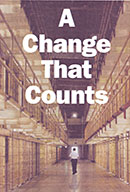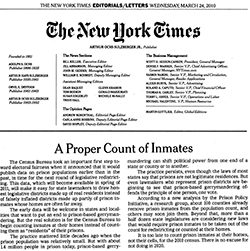The Valley Advocate profiles our work on prison-based gerrymandering.
by Peter Wagner,
April 9, 2010
Maureen Turner at The Valley Advocate has written an excellent profile of our work:
 Jail and the Census: A Change That Counts, Easthampton’s Prison Policy Initiative scores a victory for fair political representation
Jail and the Census: A Change That Counts, Easthampton’s Prison Policy Initiative scores a victory for fair political representation
I particularly liked how she explained the significance of the Census Bureau’s decision to publish prison counts earlier:
That might not sound like much — a government agency releasing a relatively small amount of its collected data a little earlier than usual. But the consequences will be significant, making it easier for states to ensure that their legislative districts are fair representations of actual populations.
And it wasn’t just those residents who were poorly served by the formula. Because the prisoners were not counted at the homes where they lived before their arrest — and where, it can be assumed, many would return upon their release — those communities also suffered, as their population count, for the purpose of distributing political representation, shrank.
While in an ideal world, Wagner said, the Census would have made a much broader chang e– to counting prisoners at their previous home addresses — such a policy would have had to be created years ago to be ready for the 2010 count. The early release of data, while not a complete fix, is still a welcomed one, he said: “It will solve a lot of people’s problems, and there was still time to do it.”
 Jail and the Census: A Change That Counts, Easthampton’s Prison Policy Initiative scores a victory for fair political representation
Jail and the Census: A Change That Counts, Easthampton’s Prison Policy Initiative scores a victory for fair political representation Importing Constituents: Incarcerated People and Political Clout in California
Importing Constituents: Incarcerated People and Political Clout in California Importing Constituents: Incarcerated People and Political Clout in Connecticut
Importing Constituents: Incarcerated People and Political Clout in Connecticut The New York Times cites our newest report,
The New York Times cites our newest report, 


